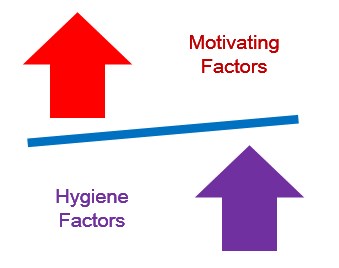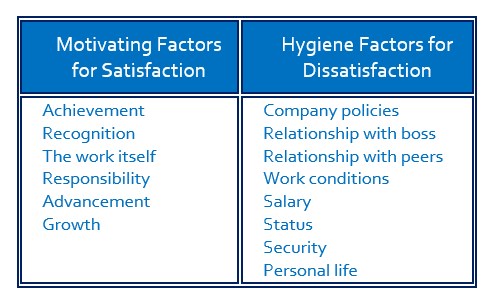Herzberg’s Two-Factor Theory
Frederick Herzberg developed a theory of workplace motivation called the Two-factor Theory or Motivation-Hygiene Theory. He first published his theory in 1959 in his book entitled “The Motivation to Work.”
His two-factor theory is based upon the idea that motivation can be separated into hygiene factors and motivation factors. Motivation factors in the workplace relate to job satisfaction, while a separate set of hygiene factors are associated with job dissatisfaction.
Motivation Factors: Factors that actually motivate an individual.
Hygiene Factors: Factors that do not have any motivational value when present, but can be a basis for dissatisfaction if not present.
About the Herzberg’s Two-Factor Theory
Herzberg theory demonstrates that satisfaction and dissatisfaction at work usually arises from different sets of factors. According to Herzberg, the factors leading to job satisfaction are separate and distinct from those that lead to job dissatisfaction. He believes the hygiene factors can demotivate or cause dissatisfaction if they are not present, but do not typically create satisfaction when present. On the contrary, he feels motivation factors do motivate or create satisfaction and are rarely the cause of dissatisfaction.
Herzberg believes fixing the causes of dissatisfaction will not create satisfaction or motivate employees, nor will adding the factors of job satisfaction eliminate job dissatisfaction. Eliminating dissatisfying job factors may create a sense of comfort or content for the employee, but not necessarily enhance his or her performance. Eliminating dissatisfying factors just placates the employee instead of actually motivating him or her to improve performance.
About Hygiene Factors
Hygiene factors are the characteristics associated with job dissatisfaction. Herzberg used the term “hygiene” in the sense that these are maintenance factors. According to Herzberg, these factors do not motivate employees. However, when they are missing, inadequate or not maintained, they can cause dissatisfaction.
Hygiene factors are extrinsic and independent of the work itself. They are needed to avoid dissatisfaction and stop employees from being unhappy, but they do not create satisfaction or motivate employees by themselves. Hygiene factors are about making an employee feel comfortable, secure, and happy. If you want to motivate or inspire the employees, you have to focus on the motivation factors.
Hygiene Factors include:
- Company policy
- Relationship with boss
- Relationship with peers
- Work conditions
- Salary
- Status
- Security
- Personal life
About Motivators
Motivation factor or satisfiers are linked to employee motivation and arise from intrinsic and dependent conditions of the job itself.
Motivators include:
- Achievement
- Recognition
- The work itself
- Responsibility
- Advancement
- Growth
A lack of motivators leads employee to focus on hygiene factors, which are the basis of many workplace complaints.
Motivating Employees
Motivating people in an organization is a two stage process.
- First, eliminate the job dissatisfactions the employees are experiencing
- Second, create the conditions for job satisfaction
Eliminate Job Dissatisfaction
First, you must address the dissatisfactions before you can motivate employees. There is no benefit in trying to motivate people until these issues have been addressed.
To eliminate job dissatisfaction, consider:
- Fixing frustrating company policies
- Providing effective and supportive supervision
- Creating and supporting a culture of respect and dignity
- Ensuring wages are competitive
- Building job status by providing meaningful work
- Providing a sense of job security
Create Conditions for Job Satisfaction
Just because someone is not dissatisfied in their work environment, doesn’t mean he or she is satisfied or motivated. To build job satisfaction, you need to address the motivating factors associated with the work itself. Things to consider include:
- Providing opportunities for achievement
- Increasing the accountability of individuals for own work
- Creating position with autonomy and independence
- Recognizing and rewarding workers’ contributions
- Creating work that challenges the employee’s skills and abilities
- Introducing new and more challenging tasks to employees
- Granting additional authority to employees
- Giving as much responsibility to each employee as possible
- Providing opportunities to advance in the company
- Offering training and development opportunities to allow employee to grow their skills


